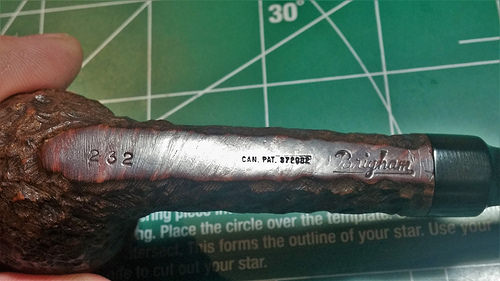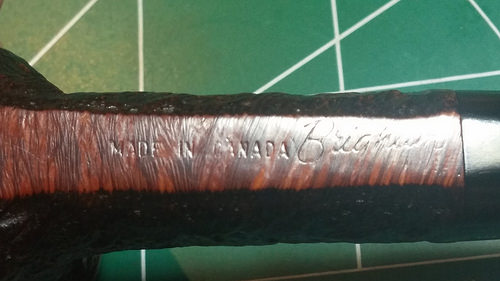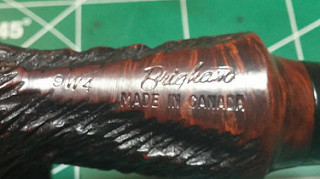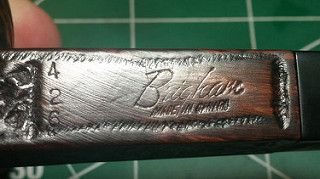Brigham Pipes – A Closer Look at Dots, Dates and Markings
This article, written by Charles Lemon, originally appeared on: DadsPipes.com, and is used here by permission. It would be wonderful to incorporate this excellent information into the main Brigham Pipes article at some point. --sethile (talk) 20:07, 18 December 2016 (CST)
Introduction
As both a Canadian and a pipe lover, it is perhaps inevitable that I hold a special place in my heart for Canadian-made pipes, especially those produced by Brigham Pipes, one of the country’s oldest pipe-makers, and one that has survived two World Wars, the Great Depression, countless lesser economic upheavals, and the more recent and radical cultural shift away from tobacco use.
I have several dozen vintage Brigham pipes in my personal collection, and over time I have developed some fluency for identifying and dating the various examples of briarwork, both pedestrian and remarkable, with which I have been fortunate to become acquainted. My goal here is to present, as clearly as possible, a concise guide to decoding the stamps, markings and other features of Brigham pipes over seven distinct periods of production.
Data for this project has been gleaned from many sources, including, but not limited to, the “official” (if scant and sometimes confused) Brigham history published on the company’s website, other online resources such as pipe logo and markings site Pipephil.eu and forum posts by other Brigham enthusiasts, and, where available, vintage catalogs and firsthand examination. If there are flaws or faults in the information presented below, I assume all responsibility and would be thrilled to receive expert correction from confirmed and documented sources.
Brigham Production Eras
Founded in 1906 by Roy Brigham in Toronto, Canada, Brigham pipes has enjoyed the patronage of customers across Canada and abroad for 110 years. Its long and successful history can be divided into seven distinct historical periods or Eras:
- Pre-Patent Era: 1906 – 1937
- Patent Era: 1938 – 1955
- Post-Patent Era 1956 – 1969 (dates approximate)
- Canadian Era 1970 – 1980 (dates approximate)
- Late Canadian Era 1980 – 2000
- Transition Era 2001 – 2006
- Italian Era 2007- Present
The Pre-Patent Era (1906 -1937) covers the early decades between the company’s start and the invention of the now-famous Brigham Rock Maple filter system. There is almost no literature available from this period and stampings or other identifying features are unknown, though presumably the Brigham name was stamped on the pipes somehow. If you have a non-system Brigham pipe in your collection, it very likely hails from this time period, though a few non-filtered Brigham pipes were produced in the late 1990s.
The Patent Era (1938-1955) is the best documented period of the company’s history, and some would say its heyday. Pipes from this period are stamped with “CAN PAT 372982” (the Canadian Patent number for the Rock maple filter system), the Brigham thin-script logo and a 3-digit shape number.
The patent on the Brigham filter system expired in 1955, ushering in the Post-Patent Era (1956 – roughly 1969). The “CAN PAT” stamp was replaced by a “Made in Canada” stamp in block letters. The 1960s saw the introduction of new product lines, including the Norsemen and Valhalla series of rusticated and smooth (respectively) freehand-style pipes created to capitalize on the growing demand for Danish pipe shapes.
Around the late 1960s or early 1970s, at the beginning of what I’ve called the Canadian Era (roughly 1970 – 1980), the stampings changed again as Brigham moved to modernize its logo. Pipes are stamped with the 3-digit shape number and “Brigham” over “Made in Canada”. Note the two variants of this stamping.
- Canadian Era Stamps



